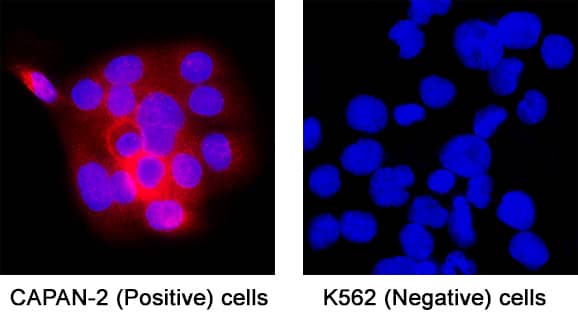Human Mesothelin Antibody
R&D Systems, part of Bio-Techne | Catalog # MAB11417

Key Product Details
Species Reactivity
Human
Applications
Immunocytochemistry
Label
Unconjugated
Antibody Source
Monoclonal Mouse IgG2B Clone # 618924
Product Specifications
Immunogen
Mouse myeloma cell line, NS0-derived human Mesothelin
Glu296-Gly580
Accession # Q13421
Glu296-Gly580
Accession # Q13421
Specificity
Detects human Mesothelin in direct ELISA.
Clonality
Monoclonal
Host
Mouse
Isotype
IgG2B
Scientific Data Images for Human Mesothelin Antibody
Detection of Mesothelin in Capan-2 (positive) and K562 cells (negative).
Mesothelin was detected in immersion fixed Capan-2 human pancreatic adenocarcinoma cells (positive), and absent in K562 human chronic myelogenous leukemia cells (negative) using Mouse Anti-Human Mesothelin Monoclonal Antibody (Catalog # MAB11417) at 8 µg/mL for 3 hours at room temperature. Cells were stained using the NorthernLights™ 557-conjugated Anti-Mouse IgG Secondary Antibody (red; Catalog # NL007) and counterstained with DAPI (blue). Specific staining was localized to cell cytoplasm. View our protocol for Fluorescent ICC Staining of Cells on Coverslips.Applications for Human Mesothelin Antibody
Application
Recommended Usage
Immunocytochemistry
8-25 µg/mL
Sample: Immersion fixed Capan‑2 human pancreatic adenocarcinoma cells (positive), and K562 human chronic myelogenous leukemia cells (negative)
Sample: Immersion fixed Capan‑2 human pancreatic adenocarcinoma cells (positive), and K562 human chronic myelogenous leukemia cells (negative)
Formulation, Preparation, and Storage
Purification
Protein A or G purified from hybridoma culture supernatant
Reconstitution
Reconstitute at 0.5 mg/mL in sterile PBS. For liquid material, refer to CoA for concentration.
Formulation
Lyophilized from a 0.2 μm filtered solution in PBS with Trehalose. *Small pack size (SP) is supplied either lyophilized or as a 0.2 µm filtered solution in PBS.
Shipping
Lyophilized product is shipped at ambient temperature. Liquid small pack size (-SP) is shipped with polar packs. Upon receipt, store immediately at the temperature recommended below.
Stability & Storage
Use a manual defrost freezer and avoid repeated freeze-thaw cycles.
- 12 months from date of receipt, -20 to -70 °C as supplied.
- 1 month, 2 to 8 °C under sterile conditions after reconstitution.
- 6 months, -20 to -70 °C under sterile conditions after reconstitution.
Background: Mesothelin
References
- Hassan, R. et al. (2004) Clin. Cancer Res. 10:3937.
- Kojima, T. et al. (1995) J. Biol. Chem. 270:21984.
- Chang, K. and I. Pastan (1996) Proc. Natl. Acad. Sci. 93:136.
- Onda, M. et al. (2006) Clin. Cancer Res. 12:4225.
- Yamaguchi, N. et al. (1994) J. Biol. Chem. 269:805.
- Muminova, Z.E. et al. (2004) BMC Cancer 4:19.
- Hou, L.-Q. et al. (2008) Develop. Growth Differ. 50:531.
- Ordonez, N.G. (2003) Mod. Pathol. 16:192.
- Argani, P. et al. (2001) Clin. Cancer Res. 7:3862.
- Li, M. et al. (2008) Mol. Cancer Ther. 7:286.
- Scholler, N. et al. (1999) Proc. Natl. Acad. Sci. 96:11531.
- Uehara, N. et al. (2008) Mol. Cancer Res. 6:186.
- Rump, A. et al. (2004) J. Biol. Chem. 279:9190.
- Ho, M. and M.O. Lively (2006) Cancer Epidemiol. Biomarkers Prev. 15:1751.
- Robinson, B.W.S. et al. (2003) Lancet 362:1612.
Alternate Names
CAK1, MPF, MSLN, SMR
Gene Symbol
MSLN
UniProt
Additional Mesothelin Products
Product Documents for Human Mesothelin Antibody
Product Specific Notices for Human Mesothelin Antibody
For research use only
